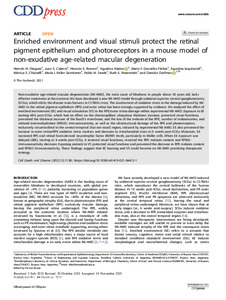Por favor, use este identificador para citar o enlazar este ítem:
https://repositorio.uca.edu.ar/handle/123456789/14600| Título: | Enriched environment and visual stimuli protect the retinal pigment epithelium and photoreceptors in a mouse model of non-exudative age-related macular degeneration | Autor: | Dieguez, Hernán H. Calanni, Juan S. Romeo, Horacio Alaimo, Agustina González Fleitas, María F. Iaquinandi, Agustina Chianelli, Mónica S. Keller Sarmiento, María I. Sande, Pablo H. Rosenstein, Ruth E. Dorfman, Damián |
Palabras clave: | DEGENERACIÓN MACULAR; FISIOPATOLOGÍA; CÉLULAS FOTORRECEPTORAS; EPITELIO PIGMENTARIO DE LA RETINA; OFTALMOLOGIA; FACTORES DE EDAD; CEGUERA; ADULTOS | Fecha de publicación: | 2021 | Editorial: | Nature Research | Cita: | Dieguez, H. H. et al. Enriched environment and visual stimuli protect the retinal pigment epithelium and photoreceptors in a mouse model of non-exudative age-related macular degeneration [en línea]. Cell Death & Disease. 2021, 12 (1128). doi: 10.1038/s41419-021-04412-1. Disponible en: https://repositorio.uca.edu.ar/handle/123456789/14600 | Resumen: | Abstract: Non-exudative age-related macular degeneration (NE-AMD), the main cause of blindness in people above 50 years old, lacks effective treatments at the moment. We have developed a new NE-AMD model through unilateral superior cervical ganglionectomy (SCGx), which elicits the disease main features in C57Bl/6J mice. The involvement of oxidative stress in the damage induced by NE-AMD to the retinal pigment epithelium (RPE) and outer retina has been strongly supported by evidence. We analysed the effect of enriched environment (EE) and visual stimulation (VS) in the RPE/outer retina damage within experimental NE-AMD. Exposure to EE starting 48 h post-SCGx, which had no effect on the choriocapillaris ubiquitous thickness increase, protected visual functions, prevented the thickness increase of the Bruch's membrane, and the loss of the melanin of the RPE, number of melanosomes, and retinoid isomerohydrolase (RPE65) immunoreactivity, as well as the ultrastructural damage of the RPE and photoreceptors, exclusively circumscribed to the central temporal (but not nasal) region, induced by experimental NE-AMD. EE also prevented the increase in outer retina/RPE oxidative stress markers and decrease in mitochondrial mass at 6 weeks post-SCGx. Moreover, EE increased RPE and retinal brain-derived neurotrophic factor (BDNF) levels, particularly in Müller cells. When EE exposure was delayed (dEE), starting at 4 weeks post-SCGx, it restored visual functions, reversed the RPE melanin content and RPE65-immunoreactivity decrease. Exposing animals to VS protected visual functions and prevented the decrease in RPE melanin content and RPE65 immunoreactivity. These findings suggest that EE housing and VS could become an NE-AMD promising therapeutic strategy. | URI: | https://repositorio.uca.edu.ar/handle/123456789/14600 | ISSN: | 2041-4889 (online) | Disciplina: | MEDICINA | DOI: | 10.1038/s41419-021-04412-1 | Derechos: | Acceso abierto | Fuente: | Cell Death & Disease Vol.12, No.1128, 2021 |
| Aparece en las colecciones: | Artículos |
Ficheros en este ítem:
| Fichero | Descripción | Tamaño | Formato | |
|---|---|---|---|---|
| enriched-environment-visual-stimuli.pdf | 7,08 MB | Adobe PDF |  Visualizar/Abrir |
Visualizaciones de página(s)
49
comprobado en 27-abr-2024
Descarga(s)
46
comprobado en 27-abr-2024
Google ScholarTM
Ver en Google Scholar
Altmetric
Altmetric
Este ítem está sujeto a una Licencia Creative Commons

